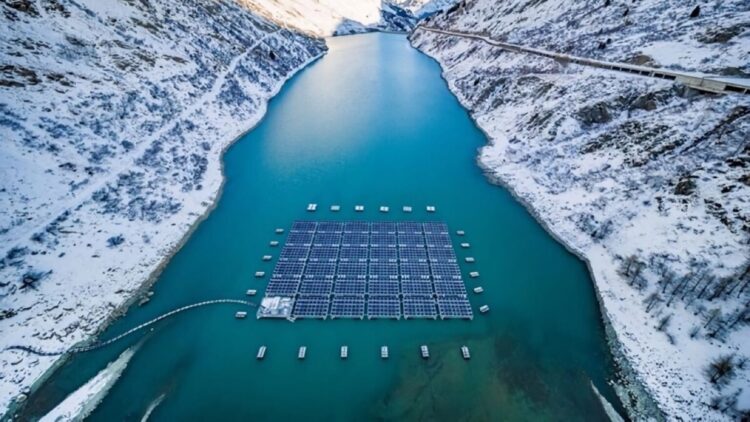The Complex Relationship and Looming Crisis Between Our Thirst For Water and Our Hunger for Energy
November 13th, 2024
Via Eco News, a look at Switzerland’s use of floating solar:

Countries around the world are striving to establish a strong foothold in the energy sector. This goal could be achieved through a diverse portfolio of projects focused on generating energy from renewable sources like solar and wind. In this context, Switzerland has sparked global interest with an innovative new approach.
Switzerland unveils groundbreaking new solar project
As many know, the global energy transition has been largely driven by renewable sources like large wind farms and solar arrays, though there are many other ways to produce clean, sustainable energy, such as large hydroelectric plants and geothermal power stations.
Switzerland has chosen one of the most popular renewable sources: solar energy. However, its major energy project goes far beyond standard land-based solar panels; the country has embraced a new innovation—floating solar panels.
It’s worth noting that floating solar panel projects have already proven to be an effective solution for generating clean energy on reservoirs, while also helping to reduce water evaporation during severe droughts.
Although the Swiss Alps aren’t currently experiencing major droughts, new reasons have emerged for installing floating solar panels there. This approach would generate entirely clean energy, contributing to reducing fossil fuel-based energy production.
What is this project based on?
Since 2019, a Swiss company called Romande Energie has been installing large floating solar farms on a reservoir in Switzerland known as Lac des Toules. This is one of the first high-altitude reservoirs to implement a floating solar farm, with a total capacity of nearly 448 kW.
Going into detail on this impressive Swiss photovoltaic project, the reservoir sits at about 1,810 meters above sea level and holds around 35 platforms of bifacial solar panels. While this may sound like it covers a large area of the lake, the solar panels only occupy about 2% of the reservoir’s surface.
The floating platforms that support the bifacial solar panels are anchored to the lakebed and remain in place from June through December, when the reservoir fills with meltwater. From January through May, as water levels recede, the platforms rest on the lakebed.
Discover the environmental impact of these solar panels
On the other hand, a group of scientists from the Zurich University of Applied Sciences has been researching the installation of solar panels on this particular reservoir. They discovered that these 35 platforms generating photovoltaic energy would recover the energy investment in just over two years.
It was also found that the results from this floating solar system show a significant reduction in carbon footprint. This installation emits approximately 94g of CO2 per kWh, a considerably lower figure compared to any traditional solar energy installation.
This major project in Switzerland represents a significant step forward in the implementation of clean, sustainable energy, contributing to the global energy transition. It may even offer certain advantages over traditionally used photovoltaic installations.
This entry was posted on Wednesday, November 13th, 2024 at 9:16 pm and is filed under Uncategorized. You can follow any responses to this entry through the RSS 2.0 feed. Both comments and pings are currently closed.
Educated at Yale University (Bachelor of Arts - History) and Harvard (Master in Public Policy - International Development), Monty Simus has held a lifelong interest in environmental and conservation issues, primarily as they relate to freshwater scarcity, renewable energy, and national park policy. Working from a water-scarce base in Las Vegas with his wife and son, he is the founder of Water Politics, an organization dedicated to the identification and analysis of geopolitical water issues arising from the world’s growing and vast water deficits, and is also a co-founder of SmartMarkets, an eco-preneurial venture that applies web 2.0 technology and online social networking innovations to motivate energy & water conservation. He previously worked for an independent power producer in Central Asia; co-authored an article appearing in the Summer 2010 issue of the Tulane Environmental Law Journal, titled: “The Water Ethic: The Inexorable Birth Of A Certain Alienable Right”; and authored an article appearing in the inaugural issue of Johns Hopkins University's Global Water Magazine in July 2010 titled: “H2Own: The Water Ethic and an Equitable Market for the Exchange of Individual Water Efficiency Credits.”